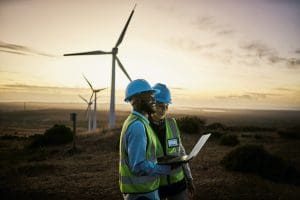Earlier this year, Schneider Electric partnered with the International Energy Agency to host the IEA’s 8th Annual Global Conference on Energy Efficiency. For three exciting days, government, and business leaders from around the world came together in Versailles, France. The conclusions of multiple engaging discussions, workshops and roundtables were summed up in the “Versailles 10×10 Actions” – a list of 10 concrete strategies to move us 10 times faster along the energy-efficiency path. That’s the rate of increase we need to unleash if we’re going to meet our collective 2050 climate goals.
Why the focus on energy efficiency? Because it’s critical to bringing about the energy transition we urgently need. And because the cleanest and cheapest “fuel” is the “fuel” you don’t use in the first place. When it comes to energy consumption, less can definitely be more.
It’s a simple enough concept. But it’s still talked about – and acted upon – too little.
In fact, the opportunity for emissions reduction through greater energy efficiency is immense, if only we can grasp it. Take just one statistic to illustrate the point: 75% of buildings in the European Union are not energy-efficient. Solutions such as electric heat pumps, thermostats, sensors and software that can optimize things like lighting, heating and air-conditioning can reduce the energy demand of buildings by around 30%. Yet at the pace at which we currently retrofit such buildings for greater energy efficiency, it will take 150 years for them all to be decarbonized. That’s far too slow to address the climate crisis we’re facing.
Energy efficiency: We have the tools, now it’s about scaling up deployment
Note that the emphasis in the “10×10” action points is not on developing new energy-efficiency solutions. After all, there are plenty of affordable digital and electric technologies already available today that can significantly reduce both energy bills and carbon emissions.
Rather, it’s on figuring out how to deploy them at greater speed and scale. And that, in turn, is largely about information and training.
The information part is about measuring energy consumption, then connecting the data, and effectively diagnosing and reporting usage via apps and other digital tools – helping users to better understand energy performance and to adapt their behavior accordingly.
This can be done easily and relatively cheaply in factories, in infrastructure, and in commercial and residential buildings (both new-build and retrofits) – and often with a faster return on investment than many realize – using technologies and software that already exist today.
To go from theory to increased action, we also need to raise awareness and knowledge, to allow us to learn from and inspire each other.
This is about everything from practical advisories for energy consumers, to showcasing examples like the World Economic Forum Manufacturing Lighthouses and other energy-efficiency role models, to sharing information that will help shift designers’ and architects’ mindsets from construction-cost-focused considerations to the total cost of ownership across a project’s entire lifecycle – in other words, optimizing designs at the outset for long-term sustainability.
Closely linked to this is the topic of upskilling and reskilling people.
Think about it: Stepping up the retrofitting of inefficient buildings, alone, means mobilizing not just more workers, but also ensuring they’re trained across more fields. An electrician working to improve energy efficiency now needs digital skills, too. A plumber installing heat pumps needs to be skilled both in water and electricity.
We need to help organize this journey across skills. Done right, this will help speed up the adoption of energy-efficiency technologies, and in the process create business opportunities in energy services and related fields, and many jobs in in retrofitting buildings for greater efficiency, for example.
Government regulation – preferably via outcome-based incentives, or “carrots,” rather than prescriptive “sticks”, and with long enough time horizons to allow for planning and adaptation – is key to galvanizing investment and action.
But corporates, including companies like Schneider Electric, also have a responsibility to embrace energy efficiency in their own operations and sites, and to help their partners, suppliers and others do so, too. That’s why we actively engage in the Alliance of CEO Climate Leaders and are one of the signatories of the alliance’s latest open letter, pledging to work together with governments to accelerate the transition to net-zero, including via greater action around energy efficiency.
What’s clear from the many valuable conversations we had at the IEA conference, and in numerous other interactions I’ve had with customers, business partners, policy makers and international organizations since then, is that the world is finally waking up to the role that energy efficiency can play in tackling climate change and building greater energy resilience.
We have the technologies. We have the knowledge. We have action points. And we have many events and organizations – COP28, New York Climate Week, the World Economic Forum, and others – to bring us all together.
So let’s not wait for new, big ideas of the future, but put what we already have to use. It’s up to everyone to act – now.



